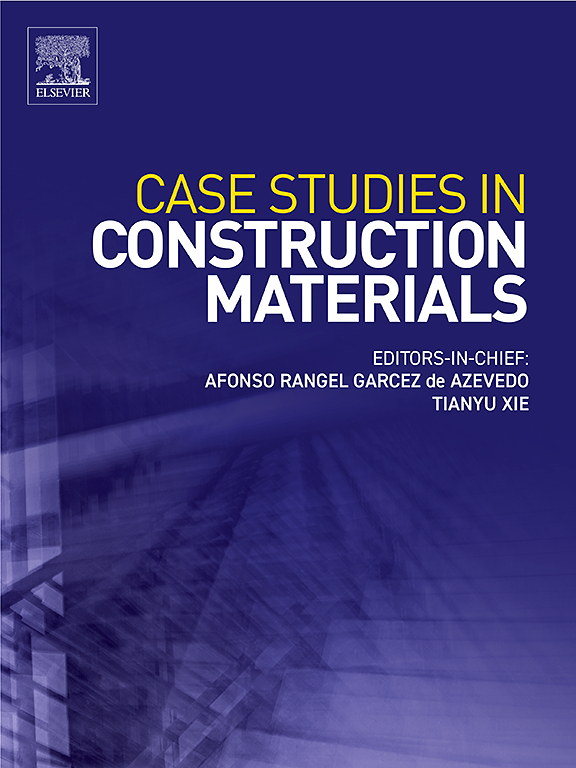Effects of curing temperature and age on the mechanical properties and damage law of coal-based solid waste cemented backfill
IF 6.6
2区 工程技术
Q1 CONSTRUCTION & BUILDING TECHNOLOGY
引用次数: 0
Abstract
Backfilling the underground caved zones with coal-based solid waste allows large-scale disposal of the waste and abates overburden damage. Since the curing temperature and age play an essential role in affecting the strength of the backfill, the uniaxial compression test, acoustic emission damage monitoring, and microscopic scanning electron microscopy were carried out on the standard cube specimens with the curing temperature of 20, 27, 35, 42.5 and 50 °C (accompanied by the curing age of 3, 7, 14 and 28 days, respectively). The microstructure evolution and damage constitutive model of coal-based waste cemented backfill (CWCB) were discussed to reveal how CWCB strength develops. The results demonstrate that: (1) The increase of curing age and temperature would underpin the mechanical properties of CWCB, since the maximum strength reached 5.45 MPa, with the curing temperature of 42.5 °C and the curing age of 28 days. (2) A curing temperature of 50 °C inflicted physical and mechanical damage on the bonding interface of the backfill. As shown by the microscopic morphology comparison (20, 27, 35, and 42.5 °C), more irregular structures inside the specimens were resulted from excessive hydration reaction. This defect triggered a dramatic ascent in the acoustic emission ringing count at 28 days of age, jeopardizing the strength to merely 76 % of that at 42.5 °C, while macroscopically, the failure was manifested as an X-shaped conjugate inclined plane shear pattern. (3) The temperature-dependent segmented damage constitutive model established based on the Weibull distribution was in good agreement with the experimental stress-strain curve. The damage-strain curve reflects three phases: slow increase, steep rise, and slow down, which correspond to the plastic deformation, damage failure and residual stages, respectively, in the stress-strain curve.
固化温度和龄期对煤基固废胶结充填体力学性能及损伤规律的影响
利用煤基固体废物对地下塌陷区进行回填,可以大规模处置废物,减轻覆盖层的破坏。由于养护温度和龄期对充填体强度有重要影响,对养护温度分别为20、27、35、42.5和50℃(养护龄期分别为3、7、14和28天)的标准立方体试件进行单轴压缩试验、声发射损伤监测和细观扫描电镜观察。探讨了废煤胶结充填体的微观结构演化和损伤本构模型,揭示了废煤胶结充填体强度的发展规律。结果表明:(1)养护龄期和养护温度的提高对CWCB的力学性能有一定的支撑作用,养护温度为42.5℃,养护龄期为28 d时,CWCB的最大强度达到5.45 MPa;(2) 50℃的养护温度对充填体粘结界面造成物理和机械损伤。在20、27、35和42.5°C的微观形貌对比中,试样内部的不规则结构更多是由于过度的水化反应造成的。该缺陷导致28日龄的声发射环数急剧上升,强度仅为42.5℃时的76 %,而宏观上,破坏表现为x形共轭斜面剪切模式。(3)基于Weibull分布建立的随温度变化的分段损伤本构模型与试验应力-应变曲线吻合较好。损伤-应变曲线表现为缓慢上升、急剧上升和缓慢下降三个阶段,分别对应应力-应变曲线中的塑性变形阶段、损伤破坏阶段和残余阶段。
本文章由计算机程序翻译,如有差异,请以英文原文为准。
求助全文
约1分钟内获得全文
求助全文
来源期刊

Case Studies in Construction Materials
Multiple-
CiteScore
7.60
自引率
19.40%
发文量
842
审稿时长
63 days
期刊介绍:
Case Studies in Construction Materials provides a forum for the rapid publication of short, structured Case Studies on construction materials. In addition, the journal also publishes related Short Communications, Full length research article and Comprehensive review papers (by invitation).
The journal will provide an essential compendium of case studies for practicing engineers, designers, researchers and other practitioners who are interested in all aspects construction materials. The journal will publish new and novel case studies, but will also provide a forum for the publication of high quality descriptions of classic construction material problems and solutions.
 求助内容:
求助内容: 应助结果提醒方式:
应助结果提醒方式:


